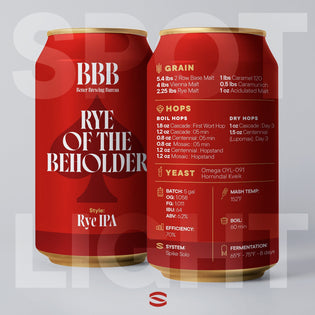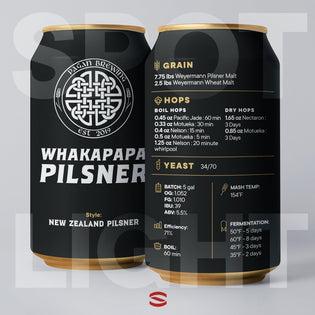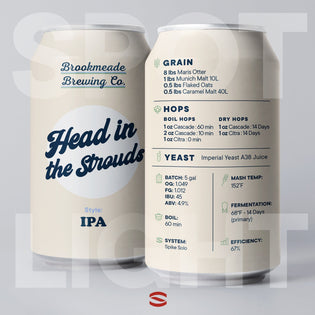
The Brewer: Kurt Green
Growing up in Eastern Canada, Bonfire Night or Guy Fawkes Night annually on November 5th was one of my favorite events. My friends and I would spend weeks collecting spruce and fir evergreen trees, for a mid-autumn bonfire and we would roast hot dogs and marshmallows over the fire.
A few years back, I thought an amber ale with a restrained smoke character would be a great callback to these times and would be a great Fall seasonal in my home brewery rotation.
The Beer: Amber Ale

Some small amounts of CTZ and Simcoe hops are added to round and accentuate the piney character of Chinook and add some minor citrus flavor. The beer is moderately dry hopped for an amber ale, and the charge is intended to add a fresh pine note to the finished beer.
I prefer to avoid yeast esters in this recipe and use a clean American yeast. Lallemand’s BRY-97 is a favorite of mine, but Fermentis US-05 or similar is a fine alternative.
Finally, I do target a common balanced water profile for Amber colored beers of: Ca 70 Mg 8 Na 16 Cl 100 So 76 HCO 20. This would not over accentuate either the malt character or the bitterness of the hops. Cheers and enjoy!
The Recipe: Fawkes Smoked Amber Ale

INGREDIENTS
GRAIN
- 16 lbs Crisp Best Ale Malt
- 2.5 lbs Briess Cherry Wood Smoked Malt
- 1.375 lbs Briess Victory Malt
- 1.25 lbs Great Western Crystal 80L Malt
- 1 lbs Briess Caramel Munich 60L Malt
- 0.5 lbs Briess Aromatic Malt
- 0.125 Weyermann Carafa Special III
HOPS
- Boil hops: 1 oz Chinook - 0:30 min
- Boil hops: 2 oz Chinook - 0:05 min
- Boil hops: 0.5 oz Simcoe - 0:05 min
- Boil hops: 0.5 oz CTZ -0:05 min
- Dry hops: 2 oz Chinook - 2 days
- Dry hops: 0.5 oz Simcoe - 2 days
- Dry hops: 0.5 oz CTZ - 2 days
YEAST
- Lallemand BRY-97 (2 Sachets)

INSTRUCTIONS
BATCH SIZE: 11 gal
OG: 1.053
FG: 1.013
IBU: 31
ABV: 5.4%
EFFICIENCY: 70% Brewhouse, 75 Mash Efficiency
MASH TEMP: 152ºF-0:60 min, 168ºF-0:10 min
BOIL: 60 min
FERMENTATION:
SYSTEM: Spike Solo
Cheers,
David Green - Fermentation Adventures
Spike Summarizes: All Things Amber Ale
What is an Amber Ale?
Amber Ale is a classic beer style known for its balanced and approachable character. It falls into the broader category of ales, characterized by its amber to reddish-brown color and a well-rounded flavor profile. Amber Ales offer a harmonious blend of malt sweetness and hop bitterness, making them a versatile and popular choice among beer enthusiasts.
What distinguishes an Amber Ale from other beers?
Amber Ales are distinguished by their medium to full-bodied nature, amber to reddish-brown hue, and a balanced combination of malt sweetness and hop bitterness. They often have a moderate alcohol content, typically ranging from 4.5% to 6.2% alcohol by volume (ABV). This balance of flavors sets them apart from beers that lean heavily toward maltiness (like brown ales) or hoppiness (like India Pale Ales).
What's the history of an Amber Ale?
The history of Amber Ale is intertwined with the broader history of ale brewing. Amber Ales have their roots in traditional British brewing, where ales were brewed with locally available ingredients. These beers were often named based on their colors or regions, and amber ales became a recognizable style due to their distinctive hue. Over time, the style has evolved, and American craft breweries have played a significant role in popularizing and expanding the Amber Ale category.
What does an Amber Ale taste like?
Amber Ales typically have a well-balanced flavor profile. You can expect a moderate to strong malt presence that imparts flavors of caramel, toffee, and sometimes a hint of toasted bread. This malt sweetness is complemented by a noticeable but not overpowering hop bitterness, which contributes floral, earthy, or citrusy notes. The result is a beer that's malt-forward with a clean, crisp finish.
How is Amber Ale brewed?
Amber Ale is brewed using a process that's similar to other ales. The key steps include mashing, boiling, fermentation, and conditioning. The choice of malts, hops, yeast strains, and brewing techniques can vary widely among breweries, leading to diverse expressions of the style. Amber Ales typically use a combination of pale, crystal, and sometimes roasted malts, which contribute to the beer's color and malt complexity. Hops are added during the boil to provide bitterness and aroma, and different hop varieties can impart distinct flavors and aromas.
What are the essential ingredients in Amber Ale?
The essential ingredients in an Amber Ale are malt, hops, water, and yeast. The specific types of malt and hops used, as well as the yeast strain, vary from one brewery to another and can significantly influence the beer's flavor and aroma. Additionally, some brewers may add specialty ingredients like spices or fruit for unique variations of Amber Ales.
What foods go best with Amber Ale?
Amber Ales are versatile when it comes to food pairings. Their balanced flavor profile complements a wide range of dishes. Here are some food pairing ideas:
- Grilled meats: The malt sweetness and hop bitterness of Amber Ale pair well with grilled steaks, burgers, and sausages.
- Barbecue: The caramel notes in Amber Ale complement the smoky and sweet flavors of barbecue dishes.
- Pizza: The balanced nature of Amber Ale makes it a great match for pizza, whether it's loaded with meats, vegetables, or both.
- Spicy cuisine: The malt sweetness can help cool down the heat in spicy dishes like Mexican or Indian cuisine.
- Cheese: Amber Ale pairs nicely with cheeses like cheddar, Gouda, and Swiss.
How strong is an Amber Ale?
A typical Amber Ale has an alcohol by volume (ABV) ranging from 4.5% to 6.2%. This places it in the moderate alcohol strength category, making it accessible to a wide range of beer drinkers.
Is Amber Ale a year round beer?
Yes, Amber Ale is a year-round beer. Its balanced and approachable character makes it suitable for any season or occasion. While some breweries may produce seasonal or limited-edition Amber Ales, you can generally find this style available year-round.
Are there different types of Amber Ale?
Amber Ale is a broad category, and within it, there can be variations. Some of these variations include:
- American Amber Ale: This style tends to have a more pronounced hop presence compared to its British counterparts, with a focus on American hop varieties.
- Irish Red Ale: A substyle of Amber Ale, Irish Red Ales are known for their reddish-brown color and a balanced malt profile with minimal hop bitterness.
- English Bitter: Although typically lighter in color than Amber Ales, some bitters may fall into the amber range. They are known for their sessionable nature and balanced malt-hop interplay.
Is an Amber Ale a good beer to brew for beginners?
Yes, Amber Ale is a great choice for beginners. Its balanced flavor profile, moderate alcohol content, and wide availability make it an accessible option for those new to craft beer. It offers a gateway into exploring the world of ales without overwhelming the palate with extreme flavors.
Are there seasonal or limited edition Amber Ales to look out for?
Many craft breweries produce seasonal or limited-edition Amber Ales throughout the year. These may incorporate unique ingredients or brewing techniques to create distinctive flavors. Keep an eye on local breweries and beer releases to discover these special offerings.
Are Amber Ales often served in a specific type of glass?
Amber Ale is often served in a pint glass or an English pub glass, both of which have a slight taper toward the top. These glass shapes allow the beer's aromas to concentrate, enhancing the overall tasting experience. Additionally, the broader base of these glasses provides stability and room for a moderate head, which can release additional aromas as you sip.
Can I age Amber Ale like I would with some other beer styles?
Amber Ales are generally not suitable for extensive aging like some high-alcohol, robust styles. However, some amber and red ales may benefit from short-term aging (up to a year) in cool, dark conditions. This can allow certain flavors to meld and mellow, enhancing the overall drinking experience.
What are some popular Amber Ales?
Popular brands of Amber Ale include:
- Newcastle Brown Ale: Known for its smooth, malty character and nutty notes.
- Fat Tire Amber Ale: Famous for its balanced sweetness and hoppy finish.
- Alaskan Amber: A well-regarded amber ale from the Alaskan Brewing Company.
- Red Seal Ale: A classic amber ale produced by North Coast Brewing Company.
- Bell's Amber Ale: A flavorful offering from Bell's Brewery with caramel and toasted malt notes.
What gives Amber Ale its distinctive color and flavor?
The distinctive color and flavor of Amber Ale come from the choice of malt. Crystal and roasted malts are often used in varying proportions. Crystal malts contribute sweetness and caramel notes, while roasted malts add color and hints of toffee and toasted bread. The balance of these malts, along with the hops and yeast, creates the characteristic taste of Amber Ale.
Why is it called Amber Ale?
Amber Ale gets its name from its distinctive amber to reddish-brown color. This hue results from the use of specific malt varieties that undergo a controlled roasting process during malting. The level of roasting influences the color and flavor of the beer.
What is the difference between an Amber Ale and a Red Ale?
Amber Ale and Red Ale are closely related styles and share many similarities. Both styles typically have a balanced malt sweetness and hop bitterness, along with a similar color range. However, the main difference lies in regional variations and specific brewery interpretations. Red Ales may lean slightly more toward caramel and toffee flavors, while Amber Ales may emphasize malt sweetness and hoppy bitterness. Ultimately, the distinction between the two can vary from brewer to brewer.
Can I find a low alcohol or N/A Amber Ale?
Yes, some breweries produce low-alcohol or non-alcoholic versions of Amber Ale, often referred to as "Session Amber Ales." These options provide the flavor and aroma of Amber Ale with reduced alcohol content, making them suitable for those who want to enjoy the taste without the effects of alcohol. Check with your local breweries or retailers for availability.
What is the best way to enjoy an Amber Ale?
To fully enjoy the aromas and flavors of Amber Ale, follow these steps:
- Pour the beer into a clean, dry glass.
- Hold the glass up to your nose and take in the aromas. Swirl the beer gently to release more scents.
- Take a sip and allow the beer to coat your palate. Pay attention to the malt sweetness, hop bitterness, and any subtle nuances.
- Take your time to savor each sip and appreciate the beer's balance and complexity.
Is an Amber Ale good for aging?
While Amber Ale is not typically aged for extended periods like some high-alcohol beers, it can benefit from short-term aging. Aging for up to a year in cool, dark conditions may allow the flavors to meld and mellow slightly, enhancing the beer's overall character. However, it's essential to store it properly and monitor the aging process to avoid unintended changes.
Can Amber Ale be used in cocktails or mixed drinks?
Yes, Amber Ale can be used in beer cocktails or mixed drinks. Its balanced flavor profile can complement various ingredients, such as fruit juices or spirits, to create refreshing and creative beverages. Some common beer cocktails that use Amber Ale as a base include the "Black and Tan" (a combination of stout and Amber Ale) and the "Snakebite" (a mix of cider and Amber Ale).





